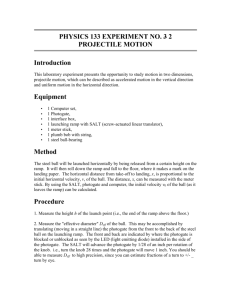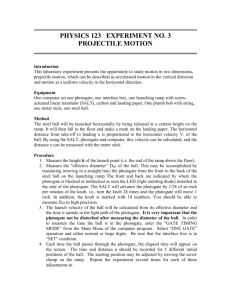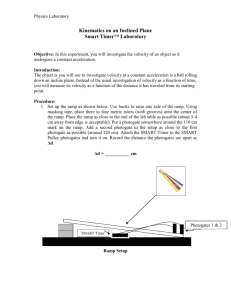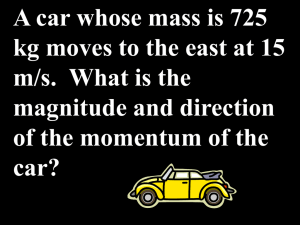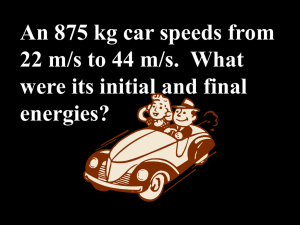This experiment concerns constant velocity in the x direction and
advertisement
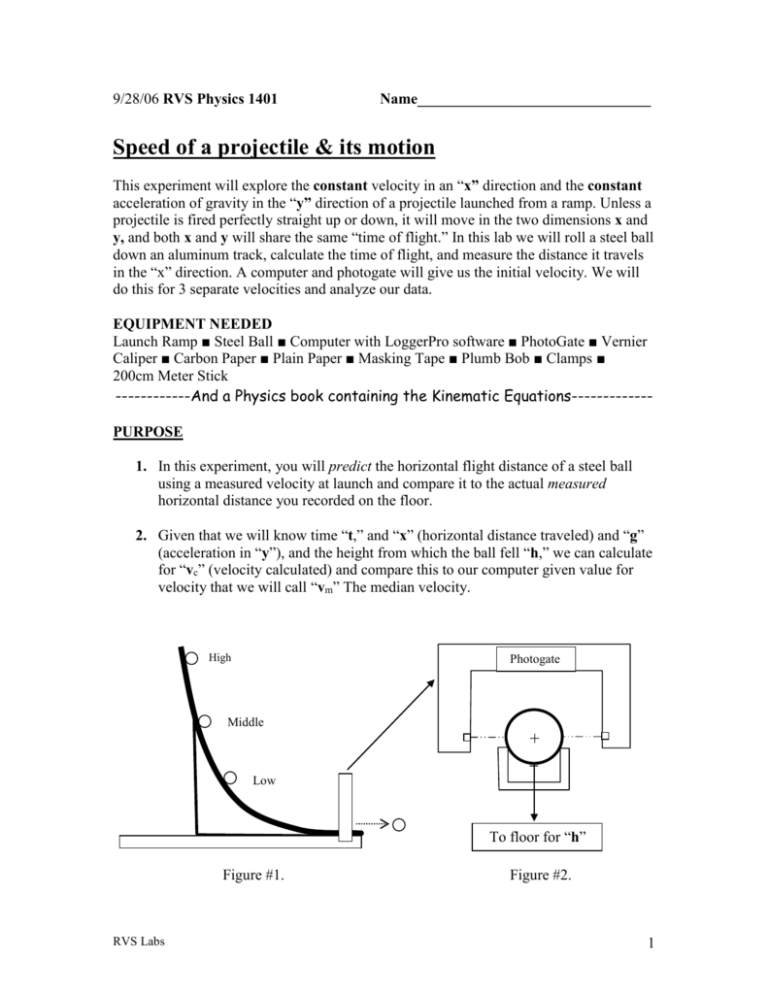
9/28/06 RVS Physics 1401 Name_______________________________ Speed of a projectile & its motion This experiment will explore the constant velocity in an “x” direction and the constant acceleration of gravity in the “y” direction of a projectile launched from a ramp. Unless a projectile is fired perfectly straight up or down, it will move in the two dimensions x and y, and both x and y will share the same “time of flight.” In this lab we will roll a steel ball down an aluminum track, calculate the time of flight, and measure the distance it travels in the “x” direction. A computer and photogate will give us the initial velocity. We will do this for 3 separate velocities and analyze our data. EQUIPMENT NEEDED Launch Ramp ■ Steel Ball ■ Computer with LoggerPro software ■ PhotoGate ■ Vernier Caliper ■ Carbon Paper ■ Plain Paper ■ Masking Tape ■ Plumb Bob ■ Clamps ■ 200cm Meter Stick ------------And a Physics book containing the Kinematic Equations------------PURPOSE 1. In this experiment, you will predict the horizontal flight distance of a steel ball using a measured velocity at launch and compare it to the actual measured horizontal distance you recorded on the floor. 2. Given that we will know time “t,” and “x” (horizontal distance traveled) and “g” (acceleration in “y”), and the height from which the ball fell “h,” we can calculate for “vc” (velocity calculated) and compare this to our computer given value for velocity that we will call “vm” The median velocity. High Photogate Middle + Low To floor for “h” Figure #1. RVS Labs Figure #2. 1 SET UP Have your Lab Tech set up the ramp. Plug the PhotoGate into your LabPro interface port “Dig Sonic 1” (located in the table drawer). Plug the USB cable from the LabPro into your computer. Open the Physics folder (located in the dock), allow time for it to load, and open the file “One Gate Timer.cmbl.” Measure the diameter of the steel ball with your Vernier caliper and record this in your data table; then enter this data (in meters) into your computer as your object length. Level the launch ramp so that the bubble level is somewhere between the green ends. You can use a folded sheet of paper to make these adjustments. Accurately measure the freefall height of the ball “h” and record this in your data table. This measurement is from the bottom of the ball to the floor. Now drop your plumb-bob from the end of the ramp to the floor. Place a piece of masking tape below it and mark its location with a pencil. This is our starting point, where the ball starts its freefall, and the point from which we will measure our horizontal distance traveled by the ball in the “x” direction. SEE FIGURES 2 & 3. Now place the PhotoGate at the end of the ramp (the horizontal part) and adjust its height so that the beam goes precisely through the center of the ball. This is a critical adjustment! Don’t disturb the ramp or the PhotoGate during the experiment. PROCEDURE You will release the ball three times from three different heights- for a total of 9 data points that you will record in the provided data table. SEE FIGURE 1 Your track has marks indicating a High point, Middle point, and a Low Point. Hit the green collect button and release the ball from the High point 3 times, each time taking care to release it from the same point (you only need to hit collect once). CATCH THE BALL IN YOUR HAND! Don’t let the ball hit the floor. Record the 3 velocities in your data table. Your velocities should be very similar. Take your median velocity and calculate (predict) the distance the ball should travel in the “x” direction using the information you know and one of your kinematics equations from your textbook. To do this you must first calculate for time “t.” Record your Prediction as “xp” in your data table. Now measure out your Predicted flight distance “xp” on the floor using your plumb-bob mark as the starting point; and place a plain sheet of paper in the middle of the impact zone. Hold the paper in place with small pieces of masking tape and draw a line perpendicular across the paper at your Predicted impact distance “xp.” SEE FIGURE 3 Now lay a piece of carbon paper face down on the sheet of paper. Launch the ball 3 more times from the exact same position used previously but now allow the ball to impact the paper on the floor. Impacts on the carbon paper will produce black dots on the paper beneath it. Measure to the center of the spread of the three dots and record this as “xm” distance Measured in your data table. RVS Labs 2 Proceed just as you did previously for the release positions Medium, and Low. So you don’t confuse impact dots with previous runs- it is a good idea after taking a measurement to put a pencil line through the previously used set of dot data. Paper T a b l e “xp” Predicted “xm” Measured R a m p Figure #3. We will now proceed to Calculate a velocity for each of the three runs using “h,” “xm,” and “t.” Find an appropriate Kinematic equation in your book for this calculation and record your answer in the data table as velocity Calculated “vc.” ANALYSIS Compare the “xp” Predicted value with the actual experimental Measurement “xm” and record it in your data table. xp xm xm 100% Compare the “vm” Median value from the computer with your “vc” Calculated value and record it in your data table. vm vc vc RVS Labs 100% 3 Data Table Diameter of ball =___________mm → ___________meters. Fall height from bottom of ball to the floor “h”=______________meters. Calculated time of flight “t”=____________seconds “v” (1) (2) (3) Release Position on ramp “vm” “xp” Median from Predicted from Computer velocities “vm” “xm” Measured To center Of spread “vc” Calculated From xm, t % Difference “xm” & “xp” % Difference “vm” & “vc” 1 2 High 3 1 2 Medium 3 1 2 Low 3 QUESTIONS 1. In your own words, why can we use the same time value of “t” for each velocity? 2. What is the velocity of the projectile in the vertical direction (y) at impact? 3. What is the velocity of the projectile at impact (both magnitude and direction)? [Use components, Show your work] 4. Where does air friction most affect this experiment? What effect does it have? 5. List two possible sources of error for this experiment. RVS Labs 4



